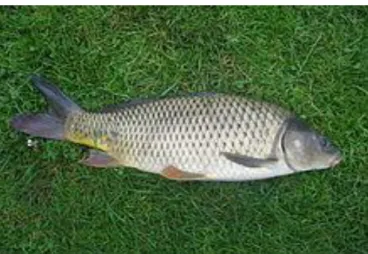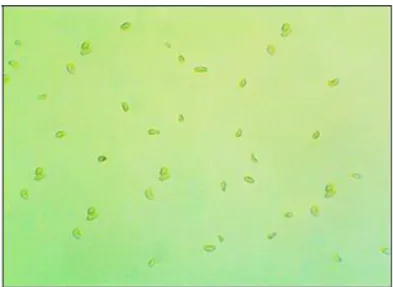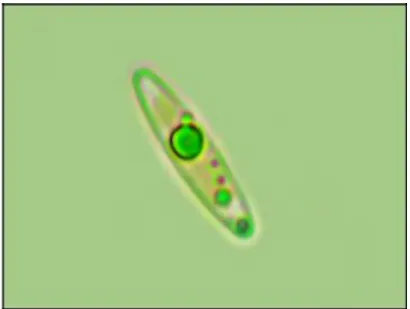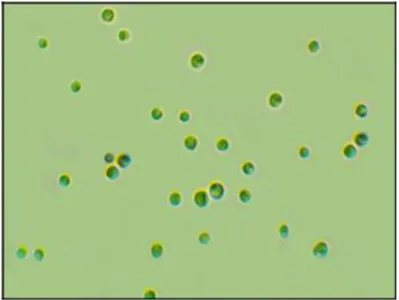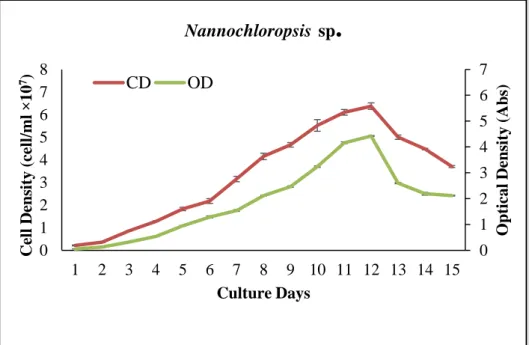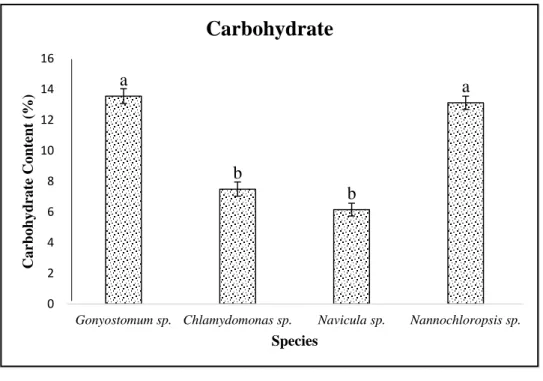HEMATO-BIOCHEMICAL INDICES OF COMMON CARP (Cyprinus carpio) BY REPLACING PART OF FISH MEAL WITH MICROALGAE POWDER ISOLATED FROM THE SOUTHEAST COAST. 51 8 Fatty acid composition of common carp fry (Cyprinus . carpio) fed with different experimental diets (Control, C5, C10, C15, CMF). 9 Amino acid profile of common carp (Cyprinus carpio) 57 10 Haematological index of common carp (Cyprinus carpio).
Triplicate groups of twenty common carp fry of uniform size were kept in each rectangular glass tank (40 L).
Chapter-1: Introduction
Objectives
To compare the hemato-biochemical indices of the common carp fry, fed with microalgae powder of Chlamydomonas sp.
Chapter-2: Review of Literature
- Microalgae
- Microalgae isolation
- Growth factors of microalgae
- Microalgal growth
- Microalgal pigments 1. Chlorophyll
- Phycobiliproteins
- Proximate composition of microalgae
- General attributes of Chlamydomonas sp
- Taxonomic classification Kingdom: Plantae
- Source of nutritional components
- Source of valuable pigments
- Source of antioxidant
- Growth factors and culture conditions
- Common Carp (Cyprinus carpio)
- Taxonomic classification Kingdom: Animalia
- Historical background
- Habitat and distribution
- Behaviour and diet
- Reproduction
- Global trade and economic value of Common Carp (Cyprinus carpio) Statistical evidence suggest that common carp production may have reached the highest
- Ecological impact
Microalgae growth is influenced by a number of factors, such as photoperiod length, temperature, pH and light intensity (Wahidin et al., 2013). For the use of microalgae in aquaculture, monitoring of cell development is considered a core component (Santos-Ballardoa et al., 2015). Nowadays, both producers and consumers are highly interested in the functional benefits of microalgae-based diets on the stress response (Elabd et al., 2020).
Changing light intensity will affect temperature which indirectly affects growth of microalgae (Huang et al., 2013).
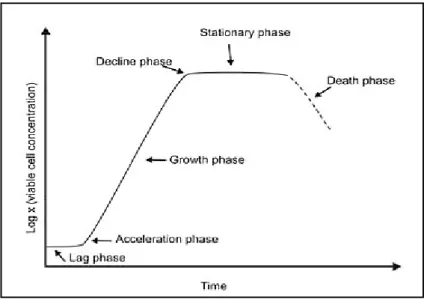
Chapter-3: Materials and Method
- Microalgae sampling site
- Sample collection and concentration
- Determination of microalgal diversity
- Isolation of microalgae
- Agar plate preparation and streak plating method
- Serial dilution
- Picking up method (Capillary method)
- Morphological identification of microalgae
- Preparation of Conway media
- Determination of growth curve
- Determination of cell density
- Determination of maximum absorbance (optical density)
- Culture of selected marine microalgae for pigment determination and analysis of proximate composition
- Determination of pigments
- Extraction of microalgae for chlorophyll determination
- Determination of chlorophyll
- Harvesting as dry algal biomass
- Experimental design for growth performance of Common Carp (Cyprinus carpio) fry
- Test diet preparation
- Feeding and water quality management
- Daily monitoring and record keeping
- Assessment of growth parameters
- Proximate composition analysis
- Nitrite-nitrogen (NO 2 -N)
- Soluble reactive phosphorous (SRP)
- Fatty acid determination
- Amino acid determination
- Analysis of blood parameters
- Statistical analysis
Following aseptic technique, wire loop or hockey stick was used to make parallel streaks of the suspension on the agar. Each of the microalgal species was grown to maintain similar environmental condition (Temperature: 24 ± 1°C; Light: 150 μEm-2s-1 intensity) until stationary phase. All the formulated test diets were approximately iso-protein and iso-lipid (crude protein-30% and lipid-6%).
After mixing all the ingredients together, a sufficient amount of water was added to form a doughy texture. The required amount of lime was used to maintain the pH of the culture tank whenever necessary. Then, 2.5 ml of the mixed solution was mixed with 0.5 ml of Folin reagent and stored in the dark for 30 minutes.
Finally, the lipid weight of the samples was calculated by subtracting the initial weight from the final weight. After more than 2 minutes but less than 10 minutes, 1 ml of NED reagent (0.5 g of the N-(1-naphthyl)-ethylenediamine dihydrochloride dissolved in 500 ml of distilled water) was added and mixed immediately. To quantify the separated fatty acids, a variety of detection techniques can be used, including ultraviolet (UV) and refractive index detectors (Farkas et al., 2018). The basic method for identifying and quantifying certain fatty acids in fish samples is to contrast the retention periods or peak areas of the FAMEs with those of common reference compounds.
Amino acid analysis (AAA) provides an absolute quantitative measure of the protein content of a sample, independent of an external protein reference standard. The use of AAA for protein identification has largely been replaced by automated Edman sequencing and MS methods. Towards the end of the feeding trial, ten fish were randomly selected from each breeding tank and clove oil (eugenol solution) was used to anesthetize the fish to measure blood parameters.
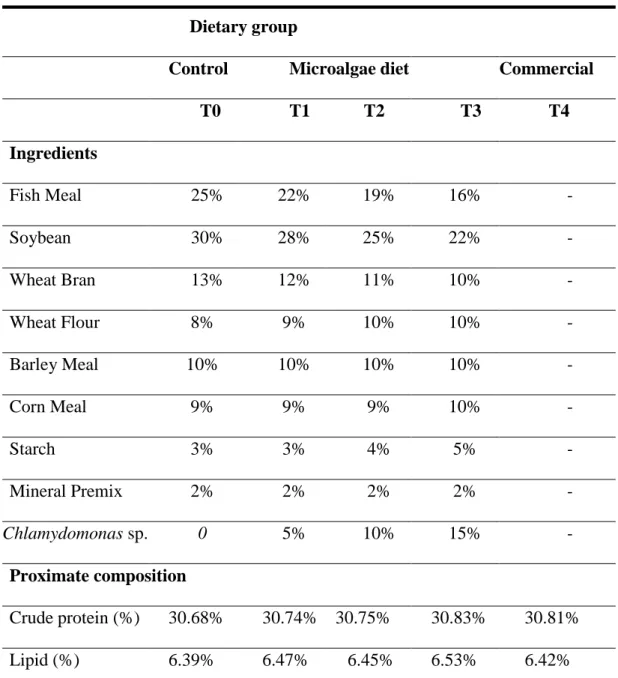
Chapter-4: Results
Sampling site
- Water quality parameters of the sampling sites
- Chlorophyll (µg/ml)
Isolated Microalgae
Morphological characteristics of isolated microalgae 1. Gonyostomum sp
Each flagellum originates from a basal granule in the anterior papillate or non-papillate region of the cytoplasm. Valves are symmetrical both apically and transapically, and may have rounded, acute, or capitate margins. All species are small, nonmotile spheres that do not express any distinct morphological features that can be distinguished by light or electron microscopy.
In the present study, different microalgae showed different cell concentrations and proximate composition, as these may vary from species to species. The figure illustrates the cell density and optical density against the cultivation time of each of the four species (Gonyostomum sp.-a, Chlamydomonas sp.-b, Navicula sp.-c, Nannochloropsis sp.-d) during cultivation in Conway media. Observational results of growth showed that onset of stationary phase (8-15 days) varied between the four species.
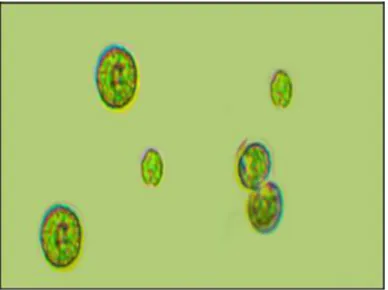
Navicula sp
Proximate composition of isolated microalgae
Protein
Lipid
Values are presented in (% dry weight) (mean ± standard error) of isolated microalgae cultured in Conway media.
Carbohydrate
- Fatty acid composition of isolated microalgae
- Amino acid profile of isolated microalgae
- Selection of suitable microalgae for feeding trial
- Physical and chemical parameters of culture water
- Growth performance of Common Carp (C. carpio) fry
- Survival rate of Common Carp (C. carpio) fry
Values with the different letters within each series indicate significant differences (p<0.05) between species. Saturated, monounsaturated and polyunsaturated fatty acids (PUFAs) are three types of fatty acids. In the current study, four microalgae showed significant variation (p<0.05) of useful fatty acids, which include SAFA, MUFA, n3-PUFA, n6-PUFA, etc.
Values with different lower case letters within individual columns are as mean ± SE (standard error) and show significance (p < 0.05), followed by Tukey's multiple range test. Among the essential amino acids, leucine seemed to predominate in the microalgae, except Nannochloropsis sp. Moreover, consistent with literature review, there is scope to investigate how this species performs as a substitute for fishmeal in the diet of common carp.
No significant differences (p<0.05) were observed in the results of temperature, DO and pH of the different treatments. Mean ± SE (Standard Error) along with different lowercase letters of chemical parameters within the same are statistically significant (p<0.05); On the contrary, the same small capital letters of physical parameters in each column that do not define any significance (p> 0.05). At the end of the feeding trial, common carp appeared healthy with no significant differences in SGR or FCR across all diets.
Length gain was higher in C15, C10, CMF, C5 and control, respectively, showing significantly higher (p<0.05) growth performance in 15% and 10% microalgae induced feed. The results showed that the survival rate was higher in the groups fed Chlamydomonas sp.
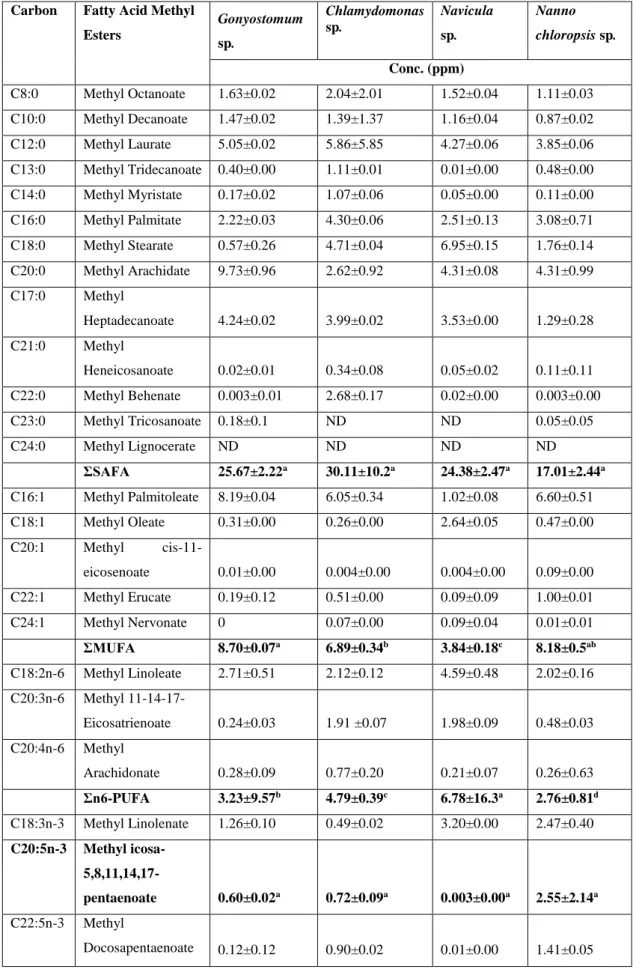
Survival rate
- Carcass proximate composition of Common Carp (C. carpio) fry
- Fatty acid composition of Common Carp (C. carpio)
- Amino acid profile of Common Carp (C. carpio) fry
- Hematological index of Common Carp (C. carpio) fry
- Biochemical index of blood serum of Common Carp (C. carpio) fry
The results also indicate that the value of carbohydrates was significantly lower (9.2%) in the control group and higher (12.7%) in the C10 treatment group. In this regard, microalgae can also be a potential substitute to reduce the demand for essential fatty acids. Here SAFA means saturated fatty acids, MUFA= monounsaturated fatty acids, n6-PUFA= ω-6 polyunsaturated fatty acids, n3-PUFA= ω-3 polyunsaturated fatty acids, DHA= docosahexaenoic acid, EPA=.
Hematological assessments are common practice in which the quality of fish and other existing organisms living in temporal places is determined. In this study, the effect of the feed with microalgae on fish hematology was recorded with different nutritional status obtained through different inclusion rate of Chlamydomonas sp. RBC, hb, Hct, WBC, LYM, PLT are the essential components of blood hematology which can act as biomarkers because significant changes of these blood parameters can also indicate the physiological changes of fish.
Changes in blood serum component help to identify certain functional disorders of body organ and health status of fish such as, total protein, albumin, globulin and A/G ratio detect blood nutrition status. This study identified significant variation in overall blood serum profile of common carp as an effect of Chlamydomonas sp.
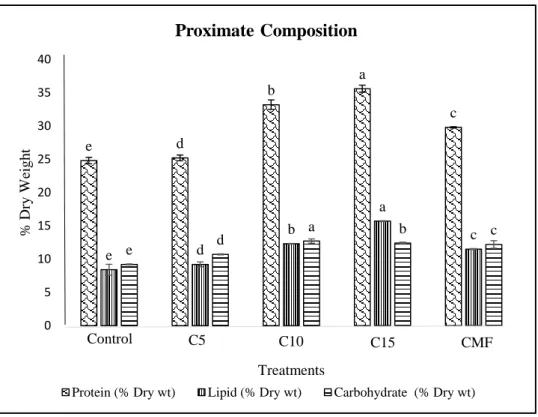
Chapter-5: Discussion
- Water quality parameters of the sampling sites
- Characterization of isolated microalgae
- Proximate composition of isolated marine water microalgae
- Fatty acid composition of isolated microalgae
- Water quality of culture tank
- Growth performance of Common Carp (C. carpio) fry
- Survival rate of Common Carp (C. carpio) fry
- Nutritional Composition of Common Carp (C. carpio) fry
- Fatty acid composition of Common Carp (C. carpio) fry
- Amino acid profile of Common Carp (C. carpio) fry
- Hematological index of Common Carp (C. carpio) fry
- Biochemical index of blood serum of Common Carp (C. carpio) fry
In the case of Nannochloropsis sp., Ermavitalini et al. 2019) reported almost similar growth pattern (layer, exponential and stationary phase) in Nannochloropsis sp. A previous study conducted by Lin et al. 2019) found slightly decreased cell numbers in Navicula sp. HDMA-20) after 18 days in BG-11 medium, whereas the highest cell density in Navicula sp. The results of the current study suggested that Navicula sp. can flourish using Conway media.
Similar growth phase orientation was observed in Chlamydomonas sp. resulting in lag phase, exponential phase, stationary phase and death phase on days 1 to 8, 9 to 15, 14 to 15 and from day 16 respectively. The same performance trend in cell density was observed by Rochaa et al. 2017) who reported that Chlamydomonas sp. On the other hand, no previous data have been reported regarding the biochemical composition of Gonyostomum sp., while in our study, relatively higher percentage of lipid and protein content was recorded from Gonyostomum sp.
Chlamydomonas sp. in contrast, lacked short-chain fatty acids (SCFAs; those with fewer than 6 carbon atoms). Moreover, in this study, non-essential amino acids from Chlamydomonas sp. was found higher than essential amino acids. Amino acid content of Nannochloropsis sp. was observed lower than the study by Hasan et al. 2022) and these changes may occur due to variations in growing conditions.
In this study, the inclusion of Chlamydomonas sp. in food leads to the improvement and maintenance of good water quality throughout the culture period. Significantly lower TAN, NO2-N and PO4-P was found in water samples from the fish tank supplemented with Chlamydomonas sp. compared to control during culture.
Chapter-6: Conclusions and Recommendations
Recommendations and future prospects
The results of growth, survival and water quality indicate the idea of microalgae selection as food and for fish well-being in commercial and scientific purposes. Hemato-biochemical data will help diagnose diseases and examine the degree of blood cell loss to assess health status and physiological improvements with microalgae diet in effective and comprehensive indices. The results will help biologists understand the systemic interactions between homeostasis and physiological modifications resulting from diet and water quality, so that standard reference values for the fish can be established.
The effect of microalgae enriched with lipids and essential fatty acids on fish will help the use of microalgae as feed not only for the development of the gonads of various fish, but also to improve the health of consumers.
Chapter-7: References
Bio-oil enrichment after hydrothermal liquefaction (HTL) of microalgae Chlorella vulgaris grown in wastewater: Bio-char and post HTL wastewater utilization studies. Effects of temperature and pH on growth and antioxidant content in the microalga Scenedesmus obliquus. Determination of seasonal changes on total fatty acid composition and ω3/ω6 ratio of carp (Cyprinus carpio) muscle lipids in Lake Beysehir (Turkey).
Extraction of Chlorophyll from Microalgae: A Review on Process Engineering Aspects, International Journal of Chemical Engineering. Extraction of Chlorophyll from Microalgae: A Review on Process Engineering Aspects, International Journal of Chemical Engineering. The promising future of microalgae: current status, challenges and optimization of a sustainable and renewable industry for biofuels, food and other products.
Effects of different salinities and pH on the growth and proximate composition of Nannochloropsis sp. Effects of CO2 and O2 concentrations and light intensity on the growth of microalgae (Euglena gracilis) in CELSS. Nutritional evaluation of microalgae oils rich in long-chain omega-3 polyunsaturated fatty acids as an alternative to fish oil.
The influence of light intensity and photoperiod on the growth and lipid content of microalgae Nannochloropsis sp. Effect of nitrogen concentration on the growth rate and biochemical composition of the microalga, Isochrysis galbana.
Appendices
Harvesting of fish
One-way analysis of variance examining the difference in protein content among the isolated microalgae
One-way analysis of variance examining the difference in lipid content among the isolated microalgae
One-way analysis of variance examining the difference in carbohydrate content among the isolated microalgae
One-way analysis of variance examining the difference in protein, lipid and carbohydrate content of whole fish body fed with different
One-way analysis of variance examining the growth performance and survival rate of Common Carp (Cyprinus carpio) fry
One-way analysis of variance examining the fatty acid composition of isolated microalgae
One-way analysis of variance examining the fatty acid composition of Common Carp (Cyprinus carpio) fry
